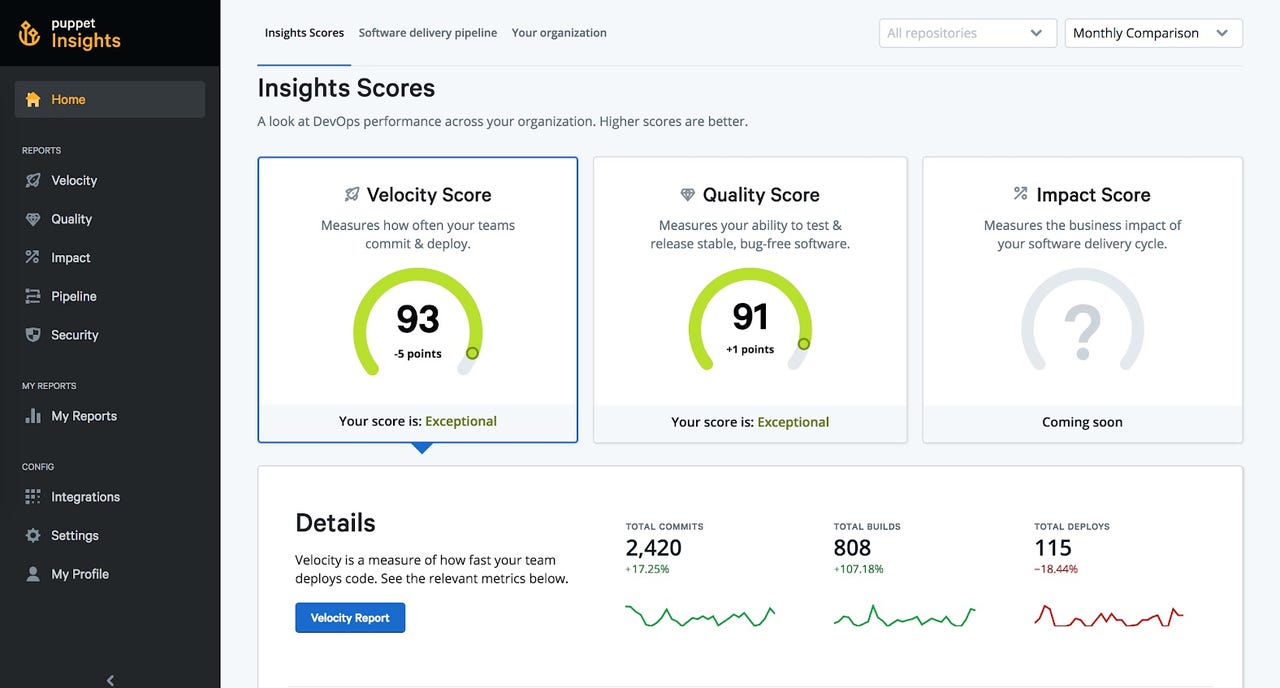Puppet rolls out new tools to measure, accelerate devOps


Puppet on Tuesday is unveiling a series of new tools and features to help businesses advance their use of devOps, including a new product to quantifiably measure and evaluate the impact of their devOps performance.
The new measurement tool, called Puppet Insights, brings together visualization tools from Puppet's recent acquisition of the startup Reflect, as well as the rich data gathered in its annual State of DevOps report.
A business doesn't need to be a Puppet customer to use Insights. The product starts by correlating data across different tools like Github, Jira, Travis CI and Puppet Pipelines. A user could, for instance, track commits from development all the way through to production. Without Insights, a company can't easily measure the progress of different departments, which may all be using different tools and processes, Alex Bilmes, senior director of product and Reflect co-founder, told ZDNet.
Enterprise Software
"Right now if you're an IT or engineering leader, you don't really have basic visibility into performance of software delivery," he said. "It's actually really hard for them to answer fundamental questions about how fast they're moving, the quality of the software they're delivering and the impact of devOps on their business."
After correlating the data, Puppet Insights enriches it with data pulled from different sources -- namely, the State of DevOps report, as well as anonymized data from other Insights users. All of this information is visualized so companies can measure their progress and compare it against other companies in their industry. It can find bottlenecks within a company's processes and provide concrete recommendations.
Puppet Insights is being released in private beta. The tool, Puppet says, should help engineering leaders make a more quantifiable business case for scaling devOps.
"We also see a lot of CIOs get excited about these tools because they are trying to show how IT is becoming a value generator for the business," Omri Gazitt, Puppet's Chief Product Officer, said to ZDNet. As they engage with other executives, "they want to show how investing in IT will lead to better results."
In addition to unveiling Puppet Insights, the company is rolling out a number of updates to its current product portfolio. Puppet Enterprise 2019 now enables users to execute tasks on unmanaged nodes. It also makes it easier to install agents on unmanaged nodes. Gazitt said that Puppet offers the first automation product, that it knows of, which supports node management via agents or agentless frameworks.
"The real story here is to bring the best of both worlds," he said.
Puppet Enterprise 2019 also now supports scheduling tasks in advance and improved functionality for end-to-end encryption. It also includes support for network device management and improved certificate handling.
Puppet Discovery, a service that scans infrastructure and applications to find out what can be automated, is also getting an update. Customers can now, directly via Discovery, take action on those discovered resources through what Puppet calls Tasks. Puppet Discovery also now offers support for OpenStack.
Puppet is also rolling out in a feature called Vulnerability Remediation. Via integrations with security providers like Qualys, Tenable and Rapid 7, Puppet Discovery eliminates traditional manual processes like spreadsheets for remediation, helping to prioritize critical IT assets and take immediate action on the most vulnerable systems. This is being introduced to a small number of customers in private beta, but Puppet anticipates introducing it to its broader customer base quickly.
Meanwhile, Puppet Pipelines for Containers now includes rich support for Helm Charts. Additionally, Continuous Delivery for Puppet Enterprise 2.0 includes a new "impact analysis" feature that enables a customer to assess which parts of their infrastructure will be impacted by changes.